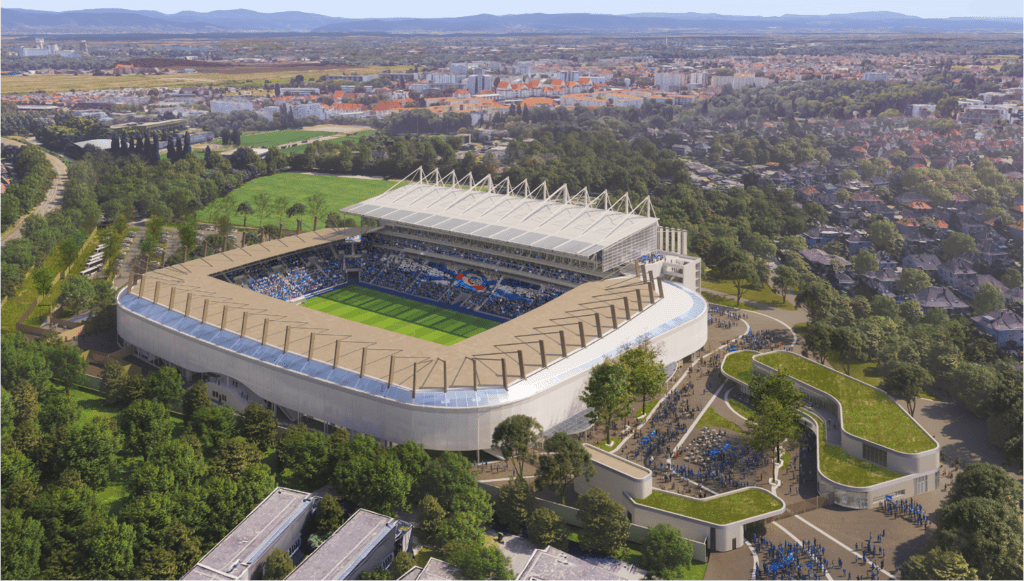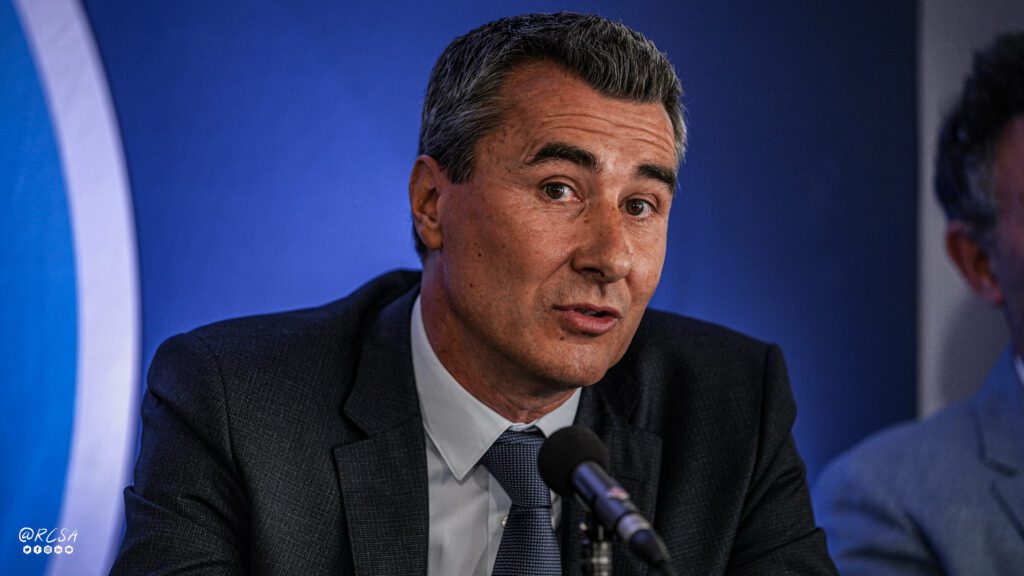Marc Keller, we imagine that this May 2, 2023 is a very important day for you…
Very important especially for the club and its ecosystem, whether it are the communities, the partners, the supporters, all the Alsatians… The announcement of the launching of the restructuring and extension works of the Meinau is a symbolic moment for two reasons. First, because the team that worked on the project is together and I would like to thank once again the local authorities for their support since the beginning; but also, because we are announcing it here, at the Meinau, in this emblematic stadium.
You usually say that the Meinau is “the other cathedral of Strasbourg”…
Yes, it’s where the heart of Alsace beats, a part of its heritage too. There are 25,000 fans who come together every two weeks to share the excitement, with family and friends. Last Friday’s match against Lyon was the 24th consecutive sell-out! And without the pandemic, the series would undoubtedly be even more impressive. The Meinau is also a gathering place, a unifying place, before and after the game, with a lot of conviviality. It is one of the best atmospheres in France, winner of the French Championship of the stands three times (2017 in League 2, 2019 and 2020 in League 1), its “blue wall”, its family stand, an increasingly young public and especially the most feminine with more than a quarter of women.

But it is also a stadium that has aged.
Indeed. It has not been renovated since 1984. Strasbourg was absent from the 1998 World Cup and Euro 2016, Racing has reached a ceiling in terms of stadium revenue … For years, the club and the local authorities have invested to try to maintain the equipment, but it was no longer viable. We are currently playing with an exemption. In the context of the competitiveness of the Ligue 1, we have fallen behind in terms of infrastructure, whether it is the stadium or the Academy and the Performance Center for Pros.
It became urgent to act?
In CFA and National, we already had record attendance. This situation led us, as soon as we were promoted to League 2, to start thinking about the stadium. Very quickly, the local authorities joined us, aware that we had to work together and do something. That was the beginning of the process. At the end of 2016, we launched the feasibility study, and then in the spring of 2019, the major orientations of the project were presented to the Eurometropole Council, which owns the facility. The team formed by the four communities and the club then gave a joint press conference announcing the launch of the project and the first public consultation meeting was held to get everyone on board.
At the beginning of 2021, the choice of the project management team, led by the Populous firm and relying on local skills, was an important moment because it was done unanimously and, therefore, today, in May 2023, the choice of the companies that will work for three seasons. Delivery is scheduled for August 2026, the year of Racing’s 120th anniversary.
What was your vision for the project?
We wanted the stadium of tomorrow with the atmosphere of today. We worked hand in hand with the local authorities, driven by a common ambition: a project that is both useful and realistic. First of all, a useful project. Useful for Racing, to perpetuate its economic model, to enable it to be more ambitious on the national and international scene and to improve its revenues to be more competitive in the face of competition that has become very tough. Useful also for the fans, by considerably improving the fan experience with better accessibility conditions, better comfort, better services, an optimized hospitality area while remaining faithful to the culture and unique atmosphere of the Meinau, which reflects the identity and values of a warm and family club. Useful, of course, for the region. As I often say, Racing is a major player in the region, a driver of economic dynamism, a vector of attractiveness and reputation and a creator of social ties. The choice was made to remain in the Meinau and to continue to contribute fully to the life of the district and its development. Finally, it is useful for the future. Because the new Meinau is an eco-responsible and sustainable project, which aims to limit its impact on the environment.

Useful, but also realistic.
Yes, because it is co-constructed and responds to everyone’s needs and challenges. It is the result of more than six years of joint work. From the outset, we wanted to build this project together with elected officials, supporters, partners and also local residents, with whom we held numerous public meetings to ensure that it would be useful to everyone. This is a very good example of putting forward the general interest of a territory. Racing brings people together! Even political changes have not called the project into question.
Was the choice to stay at the Meinau the most reasonable one?
This was the major conclusion of the feasibility study. Firstly, because this site is an integral part of the club’s history and the fans are very attached to the Meinau. Moreover, there will be no naming. There were also financial reasons: building a new stadium would have cost twice as much. Finally, there was a strong desire for environmental and eco-responsibility. Racing, a socially responsible and committed club, will contribute to the development of the neighborhood, but also to the development of soft mobility by encouraging its fans to use the streetcar, the REME or bicycles, for which we are planning 3,000 parking spaces. From the very beginning, we have imagined a “virtuous”, eco-responsible and sustainable stadium, with the objective of limiting the impact on the environment.
Will the stadium’s capacity be affected during the construction?
The phasing of the works is designed to maintain a capacity that will never fall below 19,000 seats during the various stages of the works. The final capacity will be 32,000. Our stadium will remain in its historic district and will be sized to suit the way we live football and the needs of our fans.
What will be its strong points?
First of all, a unique Fan Zone in France, accessible to all because it will be open to the neighborhood during the week, secured on gamedays and able to host the broadcasting of major sporting events, thanks to a vast square equipped with a stage and a giant screen. But also, a sheltered walkway that will allow all spectators to circulate around the stadium, promoting conviviality and sharing. Finally, the choice of grouping all the hospitality areas in the same grandstand will encourage economic and political exchanges and will allow the venue to be used outside of matches. The stadium will obviously meet international standards and will be able to host international events.
This time it’s here: the project is becoming a reality…
Many renovation or construction projects have been mentioned since 1984, but they did not become reality, for various reasons. This time, the project becomes reality. We have done what we said, we have always believed in it, despite the hazards. Today the future is taking shape: the work will start next month and in three years, the club, the city and the territory will benefit from a magnificent modern facility.
